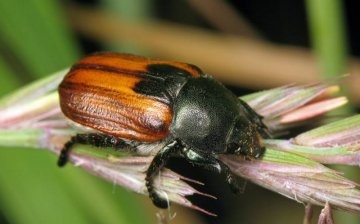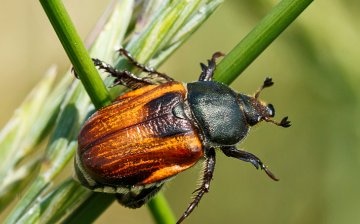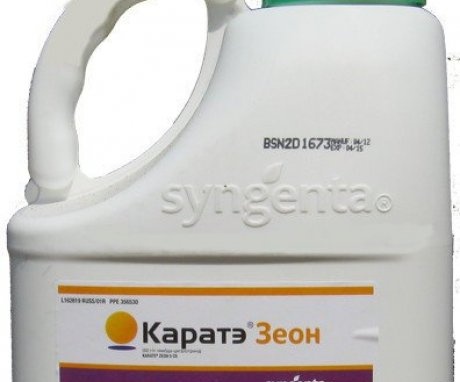Pest beetle Kuzka: the best methods of struggle
A beetle with a funny name "Kuzka" is one of the most harmful insects in wheat fields. It significantly reduces the grain yield and causes a lot of trouble for agricultural workers. This beetle is also called bread beetle because it mainly damages the grain. The fight against this pest has been going on for a long time, but it is complicated by the fact that these insects spend most of their life underground.
Content:
- What is this pest, reproduction and habitats
- The harm caused by the beetle and folk methods of struggle
- Preventive measures and chemicals
What is this pest, reproduction and habitats
This beetle belongs to the Lamellate family. Outwardly, the bugs are small, with a black abdomen and head, brown or brown colored back. Females have a black spot in the form of a triangle closer to the head. The bugs have 3 pairs of legs and are able to easily fly from place to place. The beetles have 2 flat plates on the tips of their whiskers that can spread like a fan.
The Kuzka beetle is more common in the southern part of Russia, as well as in the Caucasus. You can meet him in almost any steppe regions. This beetle has its own characteristics of the life cycle, which greatly complicates its search and struggle with it:
- Kuzka larvae can spend almost 2 years in the ground, having survived 2 winters. From tiny eggs (2 mm in diameter) larvae hatch, which remain in the ground for more than 20 months without turning into an adult. It is almost impossible to see such larvae in the fields, since they are always at a certain depth.
- The larva is rather large, up to 3 cm, white, darkens after pupation. Small larvae feed mainly on the remains of old roots, so the harm from them in the first year is not noticeable. But in the second year of life, the grown larva begins to eat fresh roots, and the plants begin to dry out actively.
- In the second year of life, the larva turns into a brown pupa. In this state, the insect spends about 14 days, after which adults appear.
- An adult Kuzka beetle lives only a month and a half, but during this time it manages to inflict significant damage on agricultural crops. The beetles feed and mate during the daytime. Both light humidity and dry summer are comfortable for them. They feed on grain, and at night they hide under grass or clods of earth.
- In a short period of life, beetles have time to lay up to 50 eggs. Females lay their eggs in the ground to a depth of 20 cm and then die without coming to the surface. After that, a new two-year cycle of the beetle's life begins.
The harm caused by the beetle and folk methods of struggle
It is hard not to feel the harm caused by kuzka. It begins to manifest itself even at the larval stage, eating the roots of agricultural crops. The beetle can harm not only wheat, but also oats, barley, rye and other cereals. Plants damaged by the larvae begin to dry out and die off, and the reason for this condition can not be determined immediately, since the larvae are not visible underground.
Adults are quite voracious and begin to attack grain from the very first moments of life, flying in flocks into the fields. In a short period of life, one such beetle can eat up to 8 g of grain, but already quite significantly.But the main damage is caused by beetles not so much by food as by the fact that they knock grain from the ears to the ground.
There are many more grains that are knocked down than they can eat, but such grain is already unsuitable for humans.
The Kuzka beetle has been known for a long time. Previously, it was simply collected by hand or knocked down with special ropes, now the folk methods of fighting the kuzka have improved:
- The beetle loves young grain, so early harvesting is often used as folk methods, before hungry beetles have time to damage it.
- The Kuzka beetle settles only at the edges of the fields, in the middle it no longer occurs, for this reason you can use a wonderful distraction. People sow cheaper crops around the perimeter of the field, which serve as food for beetles, and the field itself remains untouched.
- As a folk remedy, you can also use vinegar solution, which is sprayed with crops.
- Birch ash is also fatal to the beetle. She needs to powder the crops around the perimeter of the field. Unfortunately, this remedy is not very effective against root-eating larvae. The dusting procedure is carried out either after rain or in the morning after the appearance of dew, as it is more effective. 10 kg of ash are used for 1 hundred square meters of land. You can sprinkle ash also plots of land between the rows.
Preventive measures and chemicals
To combat the Kuzka beetle, chemicals and insecticides are often used, although traditional methods are more effective. To combat the pest, it is necessary to use sufficiently toxic substances in significant concentrations, but they begin to destroy insects after the beetles have begun to damage the ears.
The best drugs for the Kuzka beetle:
- Karate Zeon. This drug is safe for humans and animals, so it can be used to process both plants in the fields and already harvested grain. It penetrates the protective shells of the beetle's shell and affects its nervous system. As a result, the beetle stops feeding. The next stage is paralysis and death of the pest. The drug is convenient in that it is produced in granules for diluting the suspension, it is well stored and does not have a pungent odor. When spraying the ground part of the plant, about 200-300 liters per hectare is spent.
- Parachute. This drug also leads to paralysis and death of the beetle, but does not harm humans and plants. It is especially effective against hidden insect species. The action of the drug begins in the first 2 days after spraying. However, the beetle becomes addictive, so it is recommended to alternate insecticides.
- Ephoria. The drug actively fights insects and penetrates into the sap of plants, which significantly increases their resistance to unfavorable environmental factors. Even if the beetle does not get the drug, it dies after a feeding period.
Some medications are used to treat seeds before sowing to prevent bugs, but these preventative measures are not always helpful. Most often, the beetle has to be fought after it appears.
Disinfect all soil in the fields is impossible, so they resort to methods such as regular post-harvest plowing of the soil. It allows you to get rid of some of the larvae and eggs.
More information can be found in the video:













